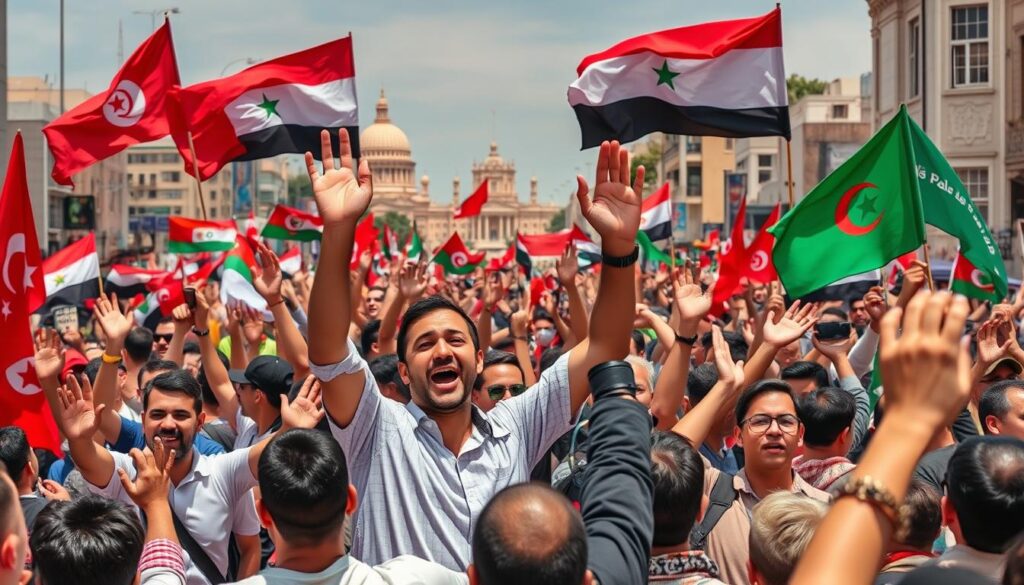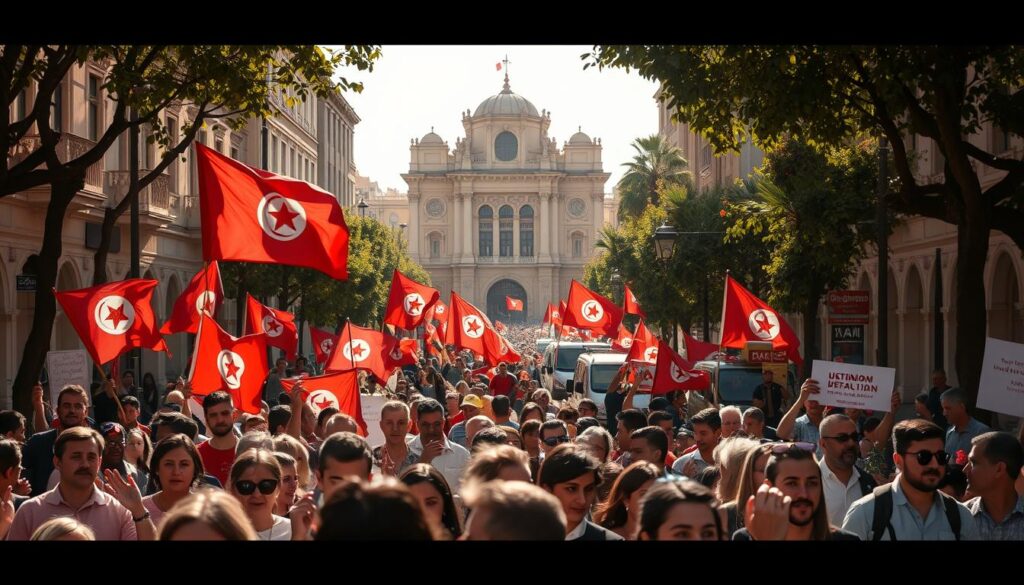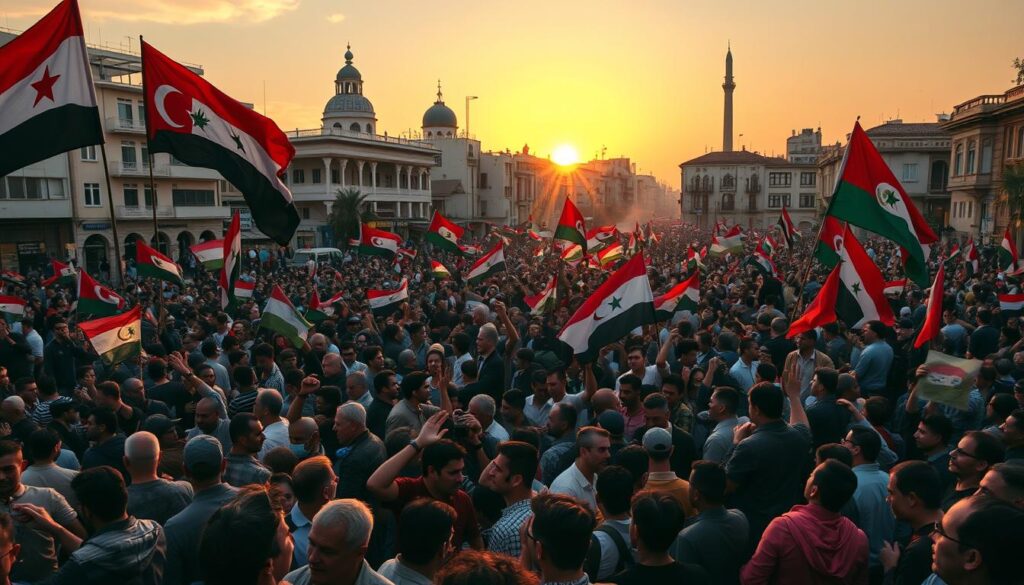The Arab Spring (2010-2012) ignited a wave of anti-government protests across the Arab world, resulting in significant political shifts, social change, and lasting impacts on the region’s future.
The Arab Spring was a protest and an effective uprisings that began in the first few years of 2010. First, it was in Tunisia because the political situation was poor and the economy was bad. Thus, this state of affairs led to new conflict in the Middle East, dozens of thousands of people were killed. In more recent years, internal conflict then migrated to Libya, Egypt, Yemen, Syria, Bahrain, and other parts in the Middle East.
Monarchs were dethroned resulting in rebellions, revolutions, and rebellions. By mid of the year 2012, the first protests have begun to disappear. Therefore, this happened because authorities and militaries dealt with the demonstrations in a violent manner.
The Arab Spring marked a struggle between religious elites trying to hold power and the growing desire for democracy in Muslim-majority states.

Key Takeaways
- The Arab Spring (2010-2012) was a series of anti-government protests and uprisings that swept across the Arab world.
- It began in Tunisia and then spread to other countries like Libya, Egypt, Yemen, Syria, and Bahrain.
- Rulers were deposed, and major social upheaval occurred, including riots, civil wars, and insurgencies.
- The initial wave of revolutions and protests faded by mid-2012 as authorities cracked down violently on demonstrators.
- The Arab Spring resulted in a battle between the consolidation of power by religious elites and the growing support for democracy.
Origins of the Arab Spring
Tunisia’s Jasmine Revolution
In December 2010, a Tunisian street vendor named Mohamed Bouazizi set himself on fire. He was upset because police took his vegetable stand without a permit. This act sparked the Jasmine Revolution in Tunisia.
Protests in Tunis eventually forced President Zine El Abidine Ben Ali to leave after 23 years. He fled to Saudi Arabia. The people were tired of corruption, economic stagnation, and authoritarianism under Ben Ali.
The tunisia jasmine revolution was the first time an Arab leader was removed by people power. It inspired others to challenge their arab spring authoritarian regimes.
“The Jasmine Revolution in Tunisia was the spark that ignited the Arab Spring, as citizens across the region rose up to demand democratic reforms and an end to decades of authoritarian rule.”

The events in Tunisia were a turning point in the causes of the arab spring. People’s anger at economic and political oppression turned into massive protests. These protests eventually brought down the regime.
This event set the stage for more uprisings in the Middle East and North Africa in the years that followed.
Egypt’s January 25 Revolution
The egyptian revolution 2011, also known as the egypt uprising of 2011, was a key moment in Middle East history. It started after Tunisia’s regime change, with young Egyptians using social media to organize protests. On January 25, 2011, huge crowds gathered across Egypt.
The government tried to calm the protests with offers and violence. But, after days of demonstrations and clashes, the army’s stance changed. They said they wouldn’t use force against protesters wanting President Hosni Mubarak gone.
With the military’s support gone, Mubarak stepped down on February 11, 2011. He had ruled for nearly 30 years. The egyptian revolution 2011 changed Egypt’s politics, starting a new uncertain era.
“The egyptian revolution 2011 was a transformative moment that captured the world’s attention and inspired hope for a more democratic future in the region.”

The egypt uprising of 2011 was complex, driven by unemployment, economic issues, and dissatisfaction with Mubarak. It started with a Tunisian street vendor’s death, but quickly spread. Egyptians demanded change in huge numbers.
The egyptian revolution 2011 had big effects, not just in Egypt but across the Arab world. Mubarak’s fall led to a new, uncertain time. Islamist groups like the Muslim Brotherhood rose, and the fight for a stable democracy continued.
Uprisings in Other Arab Countries
The Arab Spring was a wave of protests that hit the Middle East and North Africa in the early 2010s. It wasn’t just in Tunisia and Egypt. Yemen, Bahrain, and Syria also saw protests in late January, February, and March 2011.
Yemen, Bahrain, and Syria
In these countries, the protests were met with violence and long struggles. In Yemen, President Ali Abdullah Saleh faced opposition from tribal and military leaders. They joined protesters demanding his resignation.
In Bahrain, protests for reforms were crushed by security forces. They got help from a Gulf Cooperation Council force. Syria saw protests against President Bashar al-Assad, leading to a brutal crackdown and a syria civil war.
The yemen uprising of 2011–12 and the bahrain protests 2011 were key parts of the Arab Spring. They showed the varied nature of the uprisings. Some led to regime changes, while others turned into long civil conflicts.

“The Arab Spring was a series of anti-government protests, uprisings, and armed rebellions that spread across much of the Arab world in early 2010s.”
The Arab Spring (2010-2012): Key Uprisings and Political Changes
The arab spring protests changed the Middle East and North Africa from 2010 to 2012. They led to the fall of several leaders, like Zine El Abidine Ben Ali in Tunisia and Hosni Mubarak in Egypt. These political changes arab spring also caused big social unrest, including riots and civil wars.
The arab spring democracy movements started to slow down by mid-2012. Governments responded with violence, but the arab spring regime changes still had a big effect. They sparked a fight between those who wanted power and those who wanted democracy.
| Country | Economic Impact of Arab Spring |
|---|---|
| Tunisia | 5.5% loss of GDP in 2011 5.1% loss of GDP in 2012 6.4% loss of GDP in 2013 $600 lower per capita GDP in 2011 compared to counterfactual Synthetic Tunisia $574 lower per capita GDP in 2012 $735 lower per capita GDP in 2013 |
The arab spring protests had a big economic impact on countries. Their economies struggled, with low growth and high unemployment. Studies showed the Arab Spring hurt Tunisia’s economy a lot.
“More than 80 percent of registered voters in Tunisia participated in the country’s first free election for a constituent assembly on October 23, 2011.”
The arab spring democracy movements also helped civil society grow. In Yemen, groups fought against the government’s attempts to silence media and associations. New tech played a key role in connecting activists and pushing for change.
Libya’s Revolution and the Fall of Gaddafi
The libya civil war 2011 was a key moment in the Arab Spring. Protests against Muammar Gaddafi’s rule quickly turned into an armed revolt. In mid-February 2011, people took to the streets to demand Gaddafi’s resignation.
The libyan revolt of 2011 turned into a full-fledged civil war. Rebel forces aimed to overthrow Gaddafi’s long rule.
In March 2011, the rebels seemed close to defeat. An international coalition led by NATO launched a campaign of air strikes against Gaddafi’s military. This move was crucial, helping the rebels gain the upper hand. Despite Gaddafi’s efforts to hold onto Tripoli, the rebels took the city in August 2011.
The muammar gaddafi downfall happened in October 2011. He was captured and killed in Sirte. This ended the First Libyan Civil War, which lasted over 8 months and caused thousands of casualties.
“The end of the Gaddafi regime marks an historic transition for Libya. The road ahead is full of challenges, but I’m confident the Libyan people are up to the task of building a new, free Libya.”
– Hillary Clinton, former U.S. Secretary of State
The National Transitional Council (NTC) was recognized as Libya’s legal representative on September 16, 2011. But, the war’s aftermath saw factional violence. This led to another civil war in 2014, further destabilizing the country.
The libya civil war 2011 and Gaddafi’s downfall were key events in the Arab Spring. Social media and international intervention played big roles in the Libyan revolution’s outcome.
Impact and Legacy
The Arab Spring uprisings of 2010-2012 changed the Middle East deeply. They led to the fall of rulers in Tunisia, Egypt, Libya, and Yemen. People wanted democracy, fairness, and an end to corruption.
Regime Changes and Political Transitions
But, the early hopes were short-lived. Power vacuums led to fights between religious leaders and those wanting democracy. Egypt, Tunisia, and Yemen were unsure of their futures. Syria and Libya fell into civil wars.
- The fall of dictators like Zine El Abidine Ben Ali in Tunisia and Hosni Mubarak in Egypt was a big change.
- Libya’s revolution led to Muammar Gaddafi’s fall, but it plunged into a long civil war.
- In Yemen, President Ali Abdullah Saleh’s resignation started a tough transition. It was later disrupted by the Houthi uprising and ongoing civil war.
The arab spring outcomes and arab spring democracy movements faced big challenges. Arab spring regime changes were countered by foreign actions, military interventions, and civil conflicts. The arab spring impact on the middle east has brought ongoing instability and division. The arab spring historical overview is a complex chapter in the region’s story.
“The Arab Spring uprisings were a pivotal moment in the region’s history, sparking both hope and turbulence as authoritarian regimes crumbled and new power dynamics emerged.”
The Syrian Civil War
The Syrian Civil War has been a devastating conflict since the Arab Spring uprisings in 2011. President Bashar al-Assad’s crackdown on protesters led to a brutal war. This war has killed hundreds of thousands and displaced millions.
As the war grew, different groups emerged. These included moderate rebels, Islamist fighters, and the Islamic State (IS). IS once controlled a third of Syria, with Raqqa as its capital. The Syrian government, backed by Russia and Iran, used harsh tactics to keep power. This has caused massive destruction and suffering.
- By 2017, more than half of Syria’s population was displaced due to the conflict, making them reliant on humanitarian aid.
- Destruction caused by the war encompassed homes, schools, businesses, hospitals, roads, and infrastructure, estimated to be in hundreds of billions of dollars.
- The Syrian government used chemical weapons at least 50 times, including sarin and chlorine, as reported by U.S. government sources.
The Syrian Civil War has also had a profound impact on the broader region and the world. It has sparked the largest humanitarian crisis since World War II and led to the rise of extremist groups. Many peace negotiations have failed, and the conflict continues to cause suffering for Syrians.
| Statistic | Value |
|---|---|
| Civilian fatalities | More than 400,000 |
| Refugees displaced | 5.6 million |
| Decrease in life satisfaction | From 5.15 in 2008 to 2.55 in 2015 |
The Syrian Civil War has been a complex and devastating conflict. It has had far-reaching consequences for the region and the world. The international community must find a lasting peace and stability in Syria.
Regional Instability and Counterrevolutions
The arab spring did not lead to democracy in the Middle East and North Africa (MENA) region. Some authoritarian rulers were overthrown, but power vacuums led to conflicts. Countries without major oil wealth and hereditary succession faced regime changes, but hopes were not met.
Conflicts like the Syrian Civil War, the rise of ISIS, and civil wars in Libya and Yemen caused ongoing regional instability. Recent uprisings in Sudan, Algeria, Iraq, and Lebanon show the Arab world still wants reform and democracy.
“The Arab Spring encompassed a series of chaotic events in the Middle East, including the toppling of dictatorships in countries like Tunisia, Egypt, Libya, and Yemen.”
The arab spring counterrevolutions have hindered democratic hopes. Authoritarian regimes have used violence, co-opting, and external support to stay in power.
The MENA region’s ongoing instability affects countries and the global scene. The second arab spring could spark reform again. But, it must overcome big challenges and address deep-rooted issues.
The Role of Social Media
Social media was key in the Arab Spring, helping protests spread across the Middle East and North Africa. Activists used it to plan rallies, share news, and reach more people worldwide.
Before the uprisings, more people in the Arab world were online. In Bahrain, 88% of the population was online in 2011. In Egypt and Tunisia, most people used Facebook to organize and spread the word.
Social media was a spark for change, letting people share their concerns and connect. It helped topple regimes in Tunisia and Egypt. But, its impact varied, like in Libya where internet access was low.
Yet, governments tried to stop social media’s power. In Egypt, they shut down internet and phones to stop protests. This showed social media’s double role: as a tool for change and a target for control.
Social media was vital in the Arab Spring, helping protests and reaching the world. But, lasting change needs strong civil society ties, a big challenge in many Arab countries.
International Response and Intervention
The arab spring international response was complex. Some countries backed pro-democracy movements, while others supported the current regimes. This arab spring foreign intervention led to different results in the region.
In Libya, a coalition led by NATO bombed Gaddafi’s forces. This helped the rebels gain power. But in Syria, Russia and China blocked UN actions against Assad. They opposed any moves that could lead to foreign help or Assad’s ousting.
The world’s reaction was mixed. Some countries supported democracy, while others looked out for their own interests. This mix greatly influenced the Arab Spring’s path and results.
| Country | International Response | Outcome |
|---|---|---|
| Libya | NATO-led airstrikes targeting Gaddafi’s forces | Rebel forces gained control, leading to Gaddafi’s overthrow |
| Syria | Russia and China vetoed UN Security Council resolutions | Assad regime remained in power, leading to a prolonged civil war |
The arab spring international response and arab spring foreign intervention were key. They influenced the Arab Spring’s outcomes, with both support and opposition affecting the region’s democratic progress.
Ongoing Struggles and Future Prospects
The Arab Spring uprisings of 2010-2012 brought hopes for change in the Middle East and North Africa. But, finding lasting stability has been tough. Many issues and protests still face the region. Despite changes in Tunisia, Egypt, and Libya, old problems like corruption and economic issues are still big challenges.
Countries like Syria, Yemen, and Libya have seen civil wars. These wars have hurt their people a lot. Syria’s conflict, in particular, has drawn in many outside powers, making peace harder to find. In places like Bahrain, democracy movements were crushed, and strong rule has stayed.
Unresolved Issues and Renewed Protests
Recently, protests have started again in many countries. People want better lives and more freedom. In Sudan, Algeria, Iraq, and Lebanon, big protests have shown people’s anger over money problems, corruption, and not being heard.
These new protests are called the “second Arab Spring.” They show that people still want a fair society. The future is still unsure, as fights between those who want freedom and those who want to keep power go on.
| Country | Key Uprisings and Political Changes |
|---|---|
| Tunisia | President Zine El Abidine Ben Ali abdicated after street protests. Tunisia held its first democratic parliamentary elections in October 2011 post-Arab Spring. |
| Egypt | President Hosni Mubarak was ousted, but was followed by authoritarian rule. |
| Libya | Muammar Qaddafi was overthrown, triggering a civil war. Millions have fled Libya after Qaddafi’s downfall, contributing to the global refugee crisis. |
| Syria | Civil war led to many seeking refuge in neighboring countries and Europe. ISIS held a caliphate in northeastern Syria during the civil war, and Bashar al Assad remains in power. |
| Yemen | Civil war escalated post-Arab Spring, causing damage to infrastructure and tribal warfare. |
| Bahrain | Pro-democracy protests were violently suppressed by the government in 2011 and 2012. |
The Arab Spring has changed the region deeply. But, the journey to democracy and justice is still hard. The fight for a better future is ongoing.
Conclusion
The Arab Spring was a big change in the Middle East and North Africa in the early 2010s. It challenged old regimes and pushed for more freedom, jobs, and fairness. Even though it led to the fall of some dictators, the area still faces trouble, wars, and power grabs by some groups.
Scholars continue to debate the historical overview of the Arab Spring, with many issues still unresolved. Yet, the dream for change and democracy keeps alive, shown by new protests. This shows the arab spring impact on the middle east is still working towards a better future.
Economic problems like joblessness, high food costs, and wealth gaps sparked the Arab Spring. Social media and tech helped organize and spread the word of the protests. The military, cities, and young people also played big roles in the movement. The Arab Spring’s success varied by country, showing its wide reach and complexity.
FAQ
What was the Arab Spring and when did it occur?
The Arab Spring was a wave of protests and uprisings across the Arab world in the early 2010s. It started in December 2010.
What were the key uprisings and political changes that occurred during the Arab Spring?
The Arab Spring led to the fall of several authoritarian leaders. Zine El Abidine Ben Ali in Tunisia, Hosni Mubarak in Egypt, Muammar Gaddafi in Libya, and Ali Abdullah Saleh in Yemen were among them. It also caused riots, civil wars, and insurgencies in many countries.
How did the Arab Spring begin, and what were the initial protests like in Tunisia and Egypt?
It started in December 2010 when Mohamed Bouazizi set himself on fire in Tunisia. This inspired protests in Egypt, where young people used social media to gather crowds on January 25, 2011.
What was the outcome of the uprisings in other Arab countries like Yemen, Bahrain, and Syria?
Protests in Yemen, Bahrain, and Syria escalated into bloody struggles. In Yemen, President Ali Abdullah Saleh eventually resigned. Authorities swiftly crushed Bahrain’s protests, while in Syria, demonstrators against President Bashar al-Assad sparked a civil war.
How did the international community respond to the Arab Spring uprisings?
Countries around the world responded with mixed reactions. Some supported democracy, while others backed regimes for stability. In Libya, NATO helped oust Gaddafi. In Syria, Russia and China blocked UN action against Assad.
What was the impact and legacy of the Arab Spring?
The Arab Spring did not bring lasting democracy or stability. Wars in Syria, Libya, and Yemen continue. The issues that sparked the protests, like corruption and economic problems, are still there.
How did social media play a role in the Arab Spring?
Social media was key in organizing protests and sharing information. It helped protests spread, but regimes also used it to control dissent.
What are the prospects for the future of the Arab world following the Arab Spring?
The future is uncertain, with ongoing battles between regimes and democracy movements. New protests in Sudan, Algeria, Iraq, and Lebanon show the desire for change. The Arab Spring’s legacy is complex and contested.

